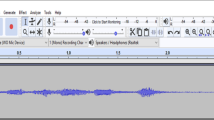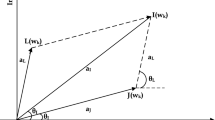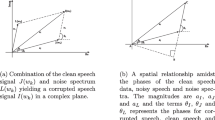Abstract
Multimedia content analysis has shown great interest over the past few decades. One of the works which find great attention to the researchers is automatic speech recognition (ASR) of speech data from broadcast radio and TV program. However, the presence of background music in such data heavily degrades the performance of ASR models. In this paper, we initially studied the temporal and spectral properties of music samples recorded from five different Indian instruments. Further, to see the effect of background Indian music on the recognition efficiency of ASR models for Hindi databases, these speech models were trained on both isolated and continuous speech databases using both clean and noisy databases. Hence, a total of four scenarios were considered: 1. Clean Isolated Database, 2. Noisy Isolated Database, 3. Clean Continuous Database, 4. Noisy Continuous Database. The variation of ASR performance was observed for different SNR levels of background music (0–30 dB). These background noises were combined with clean speech signals both independently where the sound of a single instrument was used as well as in combination with each other where sounds from several instruments were mixed. Overall, maximum degradation in performance of ASR is observed for background noise generated from audio samples of Been with an average WER of 13.37 and 72.21 for isolated and continuous text models whereas minimum degradation in performance of ASR is observed for background noise generated from audio samples of Harmonium and Flute with a WER of 15.25 and 66.09 for isolated text models and continuous text models respectively. We further correlated the observed results of ASR performance to the temporal and spectral properties of the music signals and found that higher values of Zero Crossing Rate, Roll-off rate, spectral centroid and spectral flux indicated greater degradation in ASR performance. Hence, these features are found to give important cues to understand the background noise as compared to other features like spectral entropy and Short Term Energy. The work presented in this paper will be useful in better understanding of music compensation algorithms focused on the Indian market.













Similar content being viewed by others
Explore related subjects
Discover the latest articles, news and stories from top researchers in related subjects.References
Araki, S., Hayashi, T., Delcroix, M., Fujimoto, M., Takeda, K., & Nakatani, T. (2015). Exploring multi-channel features for denoising-autoencoder-based speech enhancement. In 2015 IEEE International Conference on Acoustics, Speech and Signal Processing (ICASSP) (pp. 116–120). IEEE.
Barker, J., Marxer, R., Vincent, E., & Watanabe, S. (2015). The third chime’speech separation and recognition challenge: dataset, task and baselines. In 2015 IEEE Automatic Speech Recognition and Understanding Workshop (ASRU 2015).
Chanrungutai, A., & Ratanamahatana, C. A. (2008). Singing voice separation for mono-channel music using nonnegative matrix factorization. In International Conference on Advanced Technologies for Communications (pp. 243–246). IEEE.
Dash, D., Kim, M. J., Teplansky, K., & Wang, J., 2018. Automatic speech recognition with articulatory information and a unified dictionary for Hindi, Marathi, Bengali and Oriya. In INTERSPEECH (pp. 1046–1050).
Delcroix, M., Kubo, Y., Nakatani, T., & Nakamura, A. (2013). Is speech enhancement pre-processing still relevant when using deep neural networks for acoustic modeling?. In INTERSPEECH (pp. 2992–2996). ISCA.
Demir, C., Saraclar, M., & Cemgil, A. T. (2013). Single channel speech-music separation for robust ASR with mixture models. IEEE Transactions on Audio, Speech, and Language Processing, 21(4), 725–736.
Dua, M., Aggarwal, R. K., & Biswas, M. (2018a). Performance evaluation of Hindi speech recognition system using optimized filterbanks. Engineering Science and Technology, an International Journal, 21(3), 389–398.
Dua, M., Aggarwal, R. K., & Biswas, M. (2018b). Discriminative training using noise robust integrated features and refined HMM modeling. Journal of Intelligent Systems, 29(1), 327–344.
Dua, M., Aggarwal, R. K., & Biswas, M. (2019). GFCC based discriminatively trained noise robust continuous ASR system for Hindi language. Journal of Ambient Intelligence and Humanized Computing, 10(6), 2301–2314.
Ganji, S., Dhawan, K., & Sinha, R. (2019). IITG-HingCoS corpus: A Hinglish code-switching database for automatic speech recognition. Speech Communication, 110, 76–89.
Grais, E. M., & Erdogan, H. (2011). Single channel speech music separation using nonnegative matrix factorization and spectral masks. In 2011 17th International Conference on Digital Signal Processing (DSP) (pp. 1–6). IEEE.
Kadyan, V., Dua, M., & Dhiman, P. (2021). Enhancing accuracy of long contextual dependencies for Punjabi speech recognition system using deep LSTM. International Journal of Speech Technology, 24(2), 517–527.
Kinoshita, K., Delcroix, M., Yoshioka, T., Nakatani, T., Sehr, A., Kellermann, W., & Maas, R. (2013). The reverb challenge: a common evaluation framework for de reverberation and recognition of reverberant speech. In 2013 IEEE Workshop on Applications of Signal Processing to Audio and Acoustics (WASPAA) (pp. 1–4). IEEE.
Kumar, A., & Aggarwal, R. K. (2020). Hindi speech recognition using time delay neural network acoustic modeling with i-vector adaptation. International Journal of Speech Technology, 1–12.
Lekshmi, K. R., & Sherly, E. (2021). An acoustic model and linguistic analysis for Malayalam disyllabic words: A low resource language. International Journal of Speech Technology, 24(2), 483–495.
Li, J., Deng, L., Gong, Y., & Haeb-Umbach, R. (2014). An overview of noise-robust automatic speech recognition. IEEE/ACM Transactions on Audio, Speech, and Language Processing, 22(4), 745–777.
Londhe, N. D., & Kshirsagar, G. B. (2018). Chhattisgarhi speech corpus for research and development in automatic speech recognition. International Journal of Speech Technology, 21(2), 193–210.
Lu, X., Tsao, Y., Matsuda, S., & Hori, C. (2013). Speech enhancement based on deep denoising autoencoder. In INTERSPEECH (pp. 436–440).
Pala, M., Parayitam, L., & Appala, V. (2020). Unsupervised stemmed text corpus for language modeling and transcription of Telugu broadcast news. International Journal of Speech Technology, 23(3), 695–704.
Passricha, V., & Aggarwal, R. K. (2019). PSO-based optimized CNN for Hindi ASR. International Journal of Speech Technology, 22(4), 1123–1133.
Polasi, P. K., & Krishna, K. S. R. (2016). Combining the evidences of temporal and spectral enhancement techniques for improving the performance of Indian language identification system in the presence of background noise. International Journal of Speech Technology, 19(1), 75–85.
Povey, D., Ghoshal, A., Boulianne, G., Burget, L., Glembek, O., Goel, N., Hannemann, M., Motlicek, P., Qian, Y., Schwarz, P., & Silovsky, J. (2011). The Kaldi speech recognition toolkit. In IEEE 2011 workshop on automatic speech recognition and understanding 2011 (No. CONF). IEEE Signal Processing Society.
Raj, B., Parikh, V. N., & Stern, R. M. (1997). The effects of background music on speech recognition accuracy. In 1997 IEEE International Conference on Acoustics, Speech, and Signal Processing (Vol. 2, pp. 851–854). IEEE.
Reverb challenge. (2020). Retrieved August 29, 2020, from http://reverb2014.dereverberation.com/.
Samudravijaya, K. (2021). Indian Language Speech Label (ILSL): a de facto National Standard.
Samudravijaya, K., Rao, P. V. S., & Agrawal, S. S. (2000). Hindi speech database. In Sixth International Conference on Spoken Language Processing.
Santhanavijayan, A., Kumar, D. N., & Deepak, G., 2021. A semantic-aware strategy for automatic speech recognition incorporating deep learning models. In Intelligent System Design (pp. 247–254). Springer.
Seltzer, M. L., Yu, D., & Wang, Y. (2013). An investigation of deep neural networks for noise robust speech recognition. In 2013 IEEE International Conference on. IEEE Acoustics, Speech and Signal Processing (ICASSP) (pp. 7398–7402). IEEE.
Sprechmann, P., Bronstein, A. M., & Sapiro, G. (2012). Real-time online singing voice separation from monaural recordings using robust low-rank modeling. In ISMIR (pp. 67–72).
Upadhyaya, P., Mittal, S. K., Farooq, O., Varshney, Y. V., & Abidi, M. R. (2019). Continuous Hindi speech recognition using kaldi asr based on deep neural network. In Machine Intelligence and Signal Analysis (pp. 303–311). Springer.
Vincent, E., Barker, J., Watanabe, S., Le Roux, J., Nesta, F., & Matassoni, M. (2013). The second chime speech separation and recognition challenge: datasets, tasks and baselines. In 2013 IEEE International Conference on Acoustics, Speech and Signal Processing (ICASSP) (pp. 126–130). IEEE.
Xu, Y., Du, J., Dai, L. R., & Lee, C. H. (2014). An experimental study on speech enhancement based on deep neural networks. IEEE Signal Processing Letters, 21(1), 65–68.
Zhao, M., Wang, D., Zhang, Z., & Zhang, X. (2015). Music removal by convolutional denoising autoencoder in speech recognition. In 2015 Asia-Pacific Signal and Information Processing Association Annual Summit and Conference (APSIPA) (pp. 338–341). IEEE.
Funding
Funding was provided by BIT Mesra.
Author information
Authors and Affiliations
Corresponding author
Additional information
Publisher's Note
Springer Nature remains neutral with regard to jurisdictional claims in published maps and institutional affiliations.
Rights and permissions
About this article
Cite this article
Kumar, A., Solanki, S.S. & Chandra, M. Effect of background Indian music on performance of speech recognition models for Hindi databases. Int J Speech Technol 26, 1153–1164 (2023). https://doi.org/10.1007/s10772-021-09948-3
Received:
Accepted:
Published:
Issue Date:
DOI: https://doi.org/10.1007/s10772-021-09948-3




